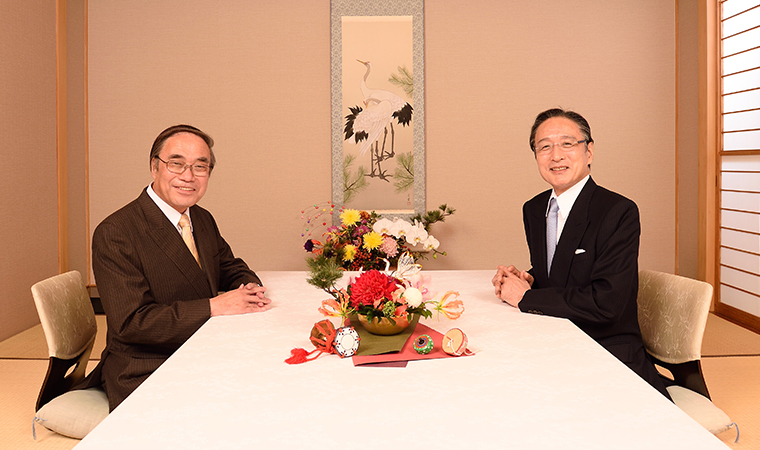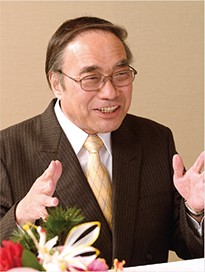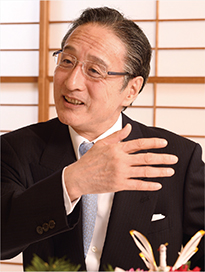
 2016 New Year Conversation Connecting Japanese Traditional Culture with the Next Generation In this year's New Year Conversation, Shinagawa City resident Mr. Kataoka, Nizaemon, the renowned kabuki actor who is designated as a Holder of an Important Intangible Cultural Property (Living National Treasure), talks about kabuki and his thoughts about the city with Mayor Hamano. A charming place to encounter new urban landscapes |
|
Mayor Hamano: How long have you lived in Shinagawa City? Mr. Kataoka, Nizaemon: It was exactly 10 years in 2015. I feel Shinagawa City is a very easy place to live. I find it quite delightful observing the city as it steadily renews itself. I had some time off when I hurt my shoulder three years ago, and I would often go on walks. I discovered that Shinagawa has many different kinds of spots. There are many birds along the canals. Hamano: The Tennozu Canal area has floating restaurants and the bridges are lit up at night, creating a new kind of urban landscape. The Shinagawa-ura area, on the other hand, is where yakatabune houseboats and fishing boats are moored, and it has an Edo era atmosphere. Nizaemon: The birds slowly swimming on the water—it soothed my heart. Hamano: Did you walk along the Kyu-Tokaido Street? Nizaemon: Around the old Shinagawa-shuku post station. The street width is the same as it was in the Edo era and there was an old geta clog shop; it would be wonderful if more of the old Edo atmosphere could be brought out. Hamano: There is the Shinagawa Shukuba Matsuri in late September, with activities such as a parade of people dressed in Edo era costumes, to communicate the local history and culture, but I feel we need to be more proactive in creating the surrounding scenery. |
On upholding a 350-year-old artistic tradition |
|
Hamano: How did you feel being accredited as a Living National Treasure last year? Nizaemon: Thankful, but there's also the feeling of serious responsibility. Mixed. Thankful but, at the same time, feeling a heavy responsibility. Hamano: Perhaps something like not being yourself anymore? Nizaemon: I feel perhaps the term “Living National Treasure” is not appropriate. (Laughing) Me, a national treasure? Hamano: (Nodding) I see. Nizaemon: But that's not it. The official name is “Holder of an Important Intangible Cultural Property” with the acting I do as the national treasure. Japan has accredited the cultural property that I perform; as a flesh-and-blood human, it's quite a serious thing. Failure is not excused. So my performances must always be worthy of being a treasure. Hamano: Kabuki is an art where the actor expresses his own originality within a traditional form. It seems completely different than television or film acting. Nizaemon: Exactly. There is a mold into which we must place our hearts and from within which we much express ourselves in our roles. This is what makes traditional performance so challenging. Hamano: Even with such a mold, there is a completely different impression depending on who is acting. Nizaemon: Yes. It becomes a completely different stage when two different actors perform the same program. It is important that I express not only my own style, but also the Kataoka house's performance style. Hamano: How does one learn a particular house's performance style? Nizaemon: It's something like the difference between schools: the educational philosophy and the way of expressing oneself are different. You become what you are raised as…. Hamano: The Nizaemon name has a 350-year history, in which you receive your art over many years and also pass on that art over many years. This fostering of the next generation is a vitally important thing. |
Cultivating the next generation in a changing environment |
|
Nizaemon: Passing kabuki on to the next generation is the most difficult. The sense of young actors tends toward becoming popular first rather than polishing their performances. The living environment today is completely different and audience's thinking about the art of kabuki is also changing. Hamano: Is the audience is also changing? Nizaemon: In older times, you would be heckled on stage if your acting was bad, so the audience made you a better actor. Hamano: Given the current environment, is there anything you say to young actors? Nizaemon: I always tell them to be strict with themselves. Even if the audience response is good, they should never believe that response 100 percent. Hamano: So you're saying they should not assume their acting is good because the audience responds well? Nizaemon: Yes. Not study their craft at that point, but steal it. I used to watch from offstage while I was waiting for my turn. Performances on DVD cannot communicate atmosphere or the depth of a performance. I am always strict on this point. |
Performances etched into the hearts of each audience member |
 Mayor Hamano, Takeshi |
Hamano: What are you conscious of each day during a performance? Nizaemon: A kabuki stage lasts 25 days. Most of the audience members attend just one performance in the run, and many people come from far away. Reminding myself of this provides me with inspiration on the stage. Hamano: So the audience makes the stage. Nizaemon: I remember the era when kabuki was in decline. It required great effort and time to draw audiences, but they would easily leave. Even with a full house, I still worry. I'm thinking, “I will not let these ones get away!” It is important to prepare yourself for that. Hamano: In that sense, the reaction of the audience day-to-day is the best barometer? Nizaemon: Yes. The best reward for me is the reaction of a pleased audience. It's no use getting drunk on applause, but I must say the applause that comes at the end of a performance provides the drive for the next one. |
Daily effort is the key to both performing and disaster preparedness |
|
|
Nizaemon: The position of mayor seems demanding because the lives of citizens are in your hands. Hamano: It's most difficult when there are earthquakes, typhoons or disasters. Nizaemon: Although this problem is not just in Shinagawa City, are there areas in which fires are a major concern? Hamano: Something needs to be done to improve access in densely built-up areas not accessible to fire trucks. Nizaemon: I will do as much as I can to protect myself. I think you need to more strongly emphasize this mode of thinking. For example, people living in high-rises need to think about what they would do when the elevators stop in an earthquake…. Hamano: Since the 2011 Great East Japan Earthquake, I have been told that even office buildings have set up emergency stockpiles on each floor. The city has also implemented dispersed storage for emergency supplies, and this is something that individuals also need to do. Nizaemon: At my home, we are prepared for an emergency by collecting rainwater and the water that comes from the air conditioning system. Hamano: That's great! They say that preparedness is the best line of defense. I honestly didn't think Kataoka Nizaemon would bring up the matter of risk management. Great art and preparation do not happen overnight. Day-to-day effort is needed. Thank you for your time today. Nizaemon: It's been my pleasure. Recorded at the Shinagawa Nadaman Garden Restaurant in the Tokyo Marriott Hotel (4-7-36 Kita-Shinagawa) |
 Mr. Kataoka, Nizaemon |
 Copyright (C) 2016 Shinagawa City. All rights reserved. |